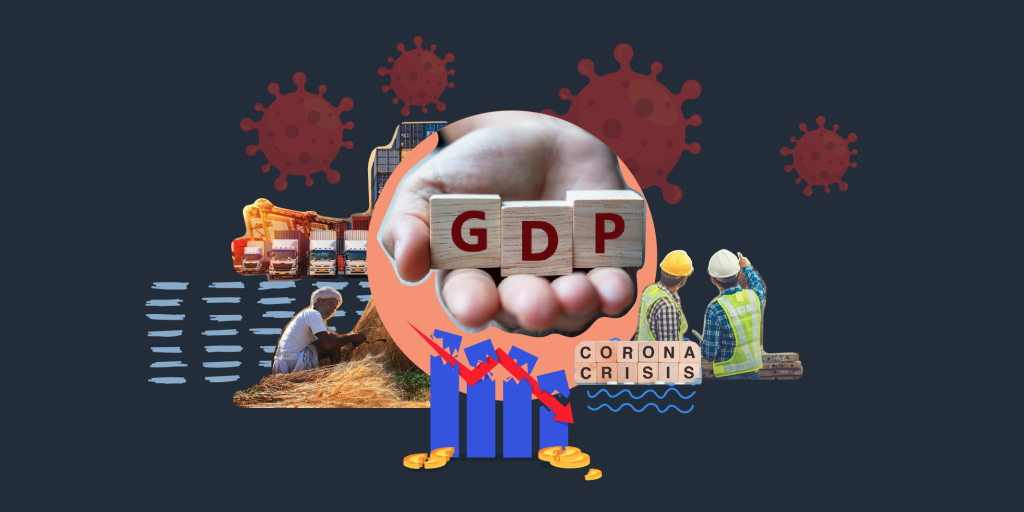Last Updated on Apr 6, 2021 by Manonmayi
It was no secret that India’s Q1 GDP growth rate for FY 2021 would be negative. And while the GDP contraction was expected to be within 20%, it defeated predictions by clocking at -23.9%! This is the worst on record. So, who’s to blame? Why did this happen? What role do the agriculture, rural, and informal sectors play in the GDP? And, what can we expect in the days to come? We answer these and other questions in this article.
This article covers:
What is to be blamed for the contraction in GDP growth rate?
What does a contraction in the GDP growth rate mean?
Why did the Q1 FY2021 GDP contract?
Comparing the key indicators of economic growth y-o-y
But what causes the gross domestic production contraction?
Why did the demand by each constituent of the GDP fall?
How much can government spending help?
Role of the agricultural and rural sectors in driving the GDP growth?
The role of the informal sector in GDP growth rate
What to expect for the next quarter and those that follow?
What is the solution, are citizens responsible too?
Table of Contents
Overview
So, our GDP has contracted to 23.9%, which is undoubtedly a matter of concern. But we need to understand that the GDP growth rate has plummeted in many other economies. Some countries have seen worse but yes, that is no consolation. However, amid this gloom, we have a tiny reason to cheer. Indian agriculture sector stood out by clocking a growth of 3.4% while others dropped severely.
What is to be blamed for the contraction in GDP growth rate?
There’s not one but two forces behind this disturbing picture. First, the pandemic and its resultant lockdown. Second, the fact that our economy was under the harrow long before the advent of coronavirus.
What does a contraction in the GDP growth rate mean?
A contraction in India’s Q1 GDP means that India’s gross domestic production has declined by 24% y-o-y. Meaning, the value of goods and services produced in the months of Apr, May, and Jun 2020 is 24% lesser than those produced in the same quarter last year.
Why did the Q1 FY2021 GDP growth rate turn negative?
Except for agriculture, all other sectors reported a fall in their GVA. What is GVA? Gross value added or GVA means the total value added to a product in the reporting year. It is calculated at an enterprise and government level. Ergo, a combined GVA of the government and enterprises forms the GDP of a country.
The above chart shows that while agriculture grew at 3.4%, all other sectors contracted during the Q1. The problem is that sectors such as construction, trade, hotels, manufacturing, and mining create the most employment opportunities in India. The significant losses in these sectors are indicative of either job losses and a rise in unemployment.
Comparing the key indicators of economic growth y-o-y
| Indicators | Q1 2019-20 | Q1 2020-21 |
| Coal production | 2.6 | -15 |
| Cement production | 1 | -38.3 |
| Steel consumption | 5 | -56.8 |
| Telephone subscribers | 1.5 | -2 |
| Sale of commercial vehicles | -9.5 | -84.8 |
| Cargo handled at major ports | 1.7 | -19.8 |
| Cargo handled at airports | -6.5 | -57.2 |
| Passengers handled at airports | -0.6 | -94.1 |
| Railways, net tonne kilometres | 0.7 | -26.7 |
Source: Indian Express
The above table is proof that Indian economy was already suffering before the advent of the coronavirus. But the unprecedented pandemic only made the situation worse. What’s more alarming is that these numbers aren’t accurate given the widespread lockdowns. When the exact numbers are released after revision, the picture may get even uglier.
But what causes the gross domestic production contraction?
To understand this, first, let’s see how is GDP calculated:
GDP = C + I + G + NX, where,
- C = Consumption by consumers or private individuals
- I = Consumption by private sector businesses
- G = Consumption by the government = G
- NX = Net demand, that is, exports minus imports
Note, India’s imports typically surpass it’s exports. So, NX’s effect on GDP is usually negative.
Let us now look at how these segments of gross domestic production have changed from 2020 to 2021
This table shows the % change in demand by the 4 segments on comparing numbers of Q1 FY2020 and Q1 FY2021.
| Sources of demand | Q1 FY2020 | Q1 FY2021 | Difference | % change |
| Demand by individual consumers | 1992967 | 1461164 | -531803 | -26.68 |
| Demand by private businesses | 1132195 | 599192 | -533003 | -47.08 |
| Demand by Government | 418249 | 486636 | 68387 | 16.35 |
| Net demand (exports – imports) | -117242 | 75675 | 192917 | 164.55 |
| Total | 3535267 | 2689556 | -845711 | -0.24 |
From the above table, it is clear that the demand from each segment of the GDP has declined for the Q1, which is why the overall GDP growth declined to 23.9%.
Why did the demand by each constituent of the GDP fall?
The reasoning is:
- Individual consumers were locked at home due to the pandemic. And only essentials that made it to their shopping list.
- Private businesses had to shut shop for over a month due to the nation-wide lockdown. Even after the curbs were lifted, massive damage had been caused to the supply chain and labour availability, which didn’t help much
- NX is positive because our imports suffered more than exports
- The government expenditure shot 16% due to the pandemic but it failed to compensate for the loss in demand in other sectors
What’s the current situation?
The already reeling economy and the pandemic has wreaked havoc in the economy. Loss of jobs and pay cuts have become a common sight these days. Though employment has begun to pick up ever since the country started going through unlock phases, expecting a rapid recovery is like expecting magic. But there’s a difference between magic and miracle. You get it, right?
So, if we report a negative GDP for the current quarter as well, India we will be slapped with the worst recession since Independence. The situation is tough:
- Household income has steeply declined, leaving little resources in people’s hands to spend on non-essential goods. This results in low demand and consumption by consumers.
- Businesses are struggling to cope with the loss in demand and so they invest less in operations. This results in a fall in private consumption as well
- Same goes for imports and exports. People and businesses will refrain from engaging in these activities due to low income and revenue
- This leaves us with just one source of demand that can shoot GDP and that is the government.
How much can government spending help?
The fair onus of boosting gross domestic production has fallen on the government, which has to increase its spending. It can do so by investing in infrastructure, paying salaries to public employees, and pumping money into the economy to aid its revival. Only when the government will spend adequately, the economy will start picking up, that too, in the short-to-medium term. If not, economic contraction is here to stay for some time. But how much expectation is a fair expectation from the government?
Our massive population is the answer to why distributing free funds to every citizen is outside the coverage. Still, the government is doing what it can by offering financial assistance to those in need of financial assistance. One instance is the transfer of money it has been doing via NREGA, PM Kisan, and other schemes. Now, this establishes that the government’s resources are depleting, and they have already, which makes both providing for the poor and investing in the economic revival a task.
Role of the agricultural and rural sectors in driving the GDP growth rate?
The fact that the agricultural sector reported a 3.4% growth in Q1 shows that the rural economy is faring better than the urban. But the agriculture sector only accounts for around 14-16% of the GDP. Meaning, growth in the agriculture sector doesn’t help the overall gross domestic production much.
But the rural economy is itself in danger. ~90% of India’s workforce belongs to the informal sector. Millions of these migrated back homes during the lockdown. To be precise, ~90 lakh labourers were ferried to their home by the Indian Railways. This brings forth a lesser-known issue. Yes, many of these migrants got back to their cities. But, are they doing well?
You see, migrant labour remits over Rs 1.5 lakh cr annually back home. This means the migrants are sending a portion of their income to their families in villages. Now, this remittance serves 10% of rural households and funds over 30% of their consumption. Meaning, the growth in urban areas is significant for rural households.
The role of the informal sector in GDP growth rate
If you look closely, the sector-wise growth numbers only include that of the formal sector. So, does this mean our GDP doesn’t consider the informal sector’s contribution at all? Well, it does. But, the growth rate of the informal sector is arrived at by using the corporate data as a proxy.
The informal sector is labelled to be ‘unorganised’; on the contrary, it is largely organised. Businesses and labourers belonging to this sector are organised under unions, associations, and other identities such as religion, caste, and gender. Now, the informal economy accounts ~90% of the total workforce in the country. It includes agriculture, whose growth rate we discussed earlier but what about others such as hawkers, tea-stallers, and road-side cobblers? They also contribute to the economy but the quantum is not formally measured.
Unfortunately, India uses surveys and the formal sector’s contribution as a proxy to arrive at the estimated value addition done by the informal sector. But is this the right way of measuring the informal sector’s GDP this time (or for that matter, anytime), because the pandemic has had a higher impact on the informal sector than the formal sector. Effectively, our informal sector is still facing a hard time so a boom in the corporate and private sectors is no fair representation of the activity in the informal sector.
What to expect for the next quarter and those that follow?
Considering the Q1 GDP growth descended lower than what was expected, experts fear that the annual gross domestic production could also be worse. The method of reporting the informal sector’s contribution is also a concern. So, monitoring and aiding the informal sector is equally important to over this nightmare.
Technically, experts opine that India is experiencing a V-shaped economic recovery. This means, they expect a quick, uninterrupted recovery in the economy after it witnessed a sharp decline. As such, they expect a better performance in the upcoming quarters but nothing remarkable because consumption and demand may remain weak through the year. So, an immediate improvement in the GDP growth may not be on the cards for India.
What is the solution, are citizens responsible too?
The economy cannot be locked down for an indefinite period. And so, it has to go on, which is happening. But economic recovery is not just the government’s responsibility. Citizens are equally responsible, especially when the pandemic is in the picture. So, what can citizens do? The answer is a no-brainer.
Taking precautionary measures to stop infection is a good step to economic revival. Remember that it is we who make an economy. If we continue with our course of life accepting the pandemic but acting irresponsibly without taking precautions, we have a serious problem at hand. So, we ask, how long do we play this blame game? A good point to remember is that there’s no winner here. Every citizen is at stake.
Conclusion
Recession is defined as 2 consequent quarters reporting negative GDP growth. One is down and the next is likely on the horizon. While experts say that the current quarter may report better numbers, what exactly is better? Because we are already in negative territory. Also, CRISIL predicts that if the next quarter reports a negative gross domestic production, India would witness its 4th recession since independence, 1st since liberalisation, and the worst ever.
But given the rapid spread of the infection, expecting a V-shaped recovery is our only hope. This also depends on government spending and consumers’ willingness to spend. That is why, despite what’s being done, expecting an immediate remarkable improvement in the economic scenario would be equal to disappointing yourself.
- Top Large Cap Funds 2025: Discover Blue Chip Performers - Mar 27, 2025
- Gilt Funds in India: Features, Meaning, and Advantages - Mar 13, 2025
- Best Index Funds in India 2025: Top Performing Mutual Funds - Mar 13, 2025





one of the best article i even read on this topic. Thanks ticker tape for explaining everything in a comprehensive way. My only concern is how we gonna know when you upload new article? do you have any telegram app ?
Hey there! Thanks a lot. We are glad you enjoy our articles. We post every Tuesdays and Thursdays, so feel free to check out our blogs regularly Also, here’s the link to Telegram bit.ly/32rk0Sp. But would you like it if we email you every time we post an article on the blog?
Also, here’s the link to Telegram bit.ly/32rk0Sp. But would you like it if we email you every time we post an article on the blog?
This means our economy was already in problem before pendamic. Big question is that ‘V’ shape growth or ‘W’ shape ?.
What is your opinion about “make in India” and “Atmanirbhar Bharat”; did it really helped for our economy and will they help in near future ?
Companies left China are attracted by our Govt. and will this movement will play major role in our growth story ?.
Thanks.
Hey Bharat, that’s a good question there.
Before the contraction in GDP growth was announced, experts opined we would witness a V-shaped recovery. However, Q1 FY2021 growth rate shocked experts and commoners alike. Now, some experts say we may have a W-shaped recovery. The reason is simple. First, some of our sectors were already suffering even before the pandemic. Second, the pandemic made things worse for these sectors and out others down too. Third, with only agriculture doing well and limited government spending, we cannot expect immediate recovery. Since most of the curbs are lifted now, some sectors may do better but not remarkably well. Also, cases in India are not reducing. We are reaching new highs every day. Will this impact our Q2 GDP rate? Of course, yes. So, until India reaches its peak, and people regain their income and spending capacity, recovery would be slow. So, we need to wait and watch the movement of our GDP growth. Will the Q2 GDP rate will be any better? And what about the ones that follow? Or will their trend be bumpy? All these factors essentially determine whether we will witness a V-shaped or W-shaped recovery. Remember that if India reports a negative GDP for Q2, we will officially be in recession. That would determine what’s likely: V- or W-shaped recovery.
About “Make in India” and “Atmanirbhar Bharat”: these are excellent initiatives to make India self-reliant and capitalise on the situational advantage that the pandemic has given us. However, a campaign can only be successful if there’s ample support in terms of finance, infrastructure, and technology. It will also require for big and small companies to come together or merge so as to enjoy synergy, which is vital in a situation like now. If this is doable, we can make something of these campaigns and write a growth story worth reading. If businesses and government deviate from the bigger picture, it is easy to lose the opportunity.
Your beat the street game Is best for small investors
Thanks, Auwais